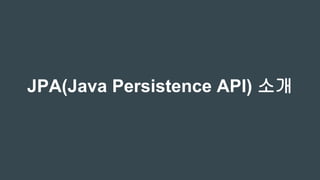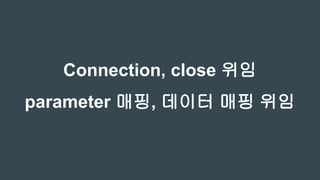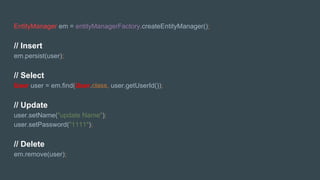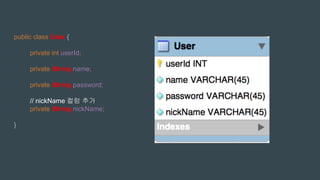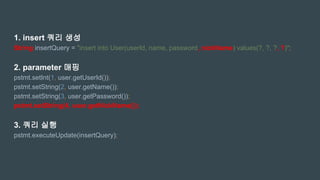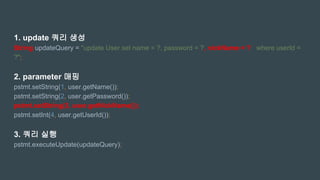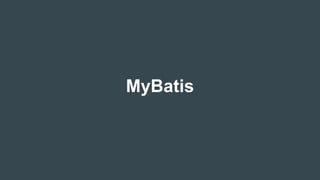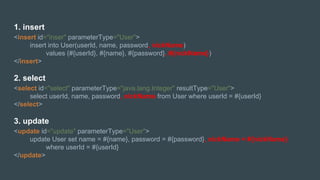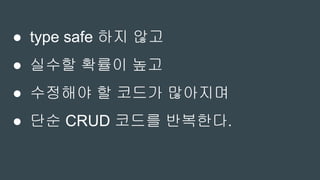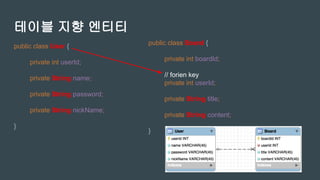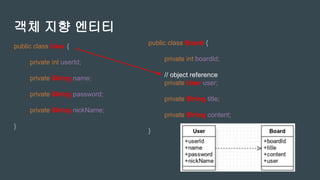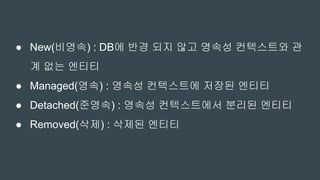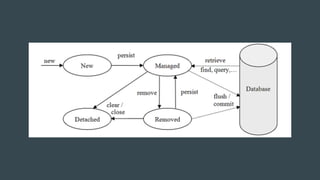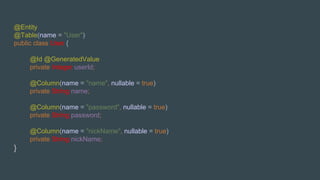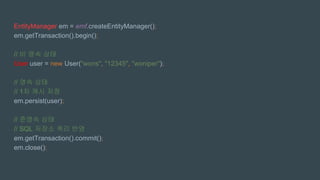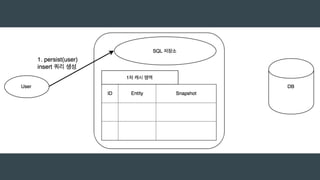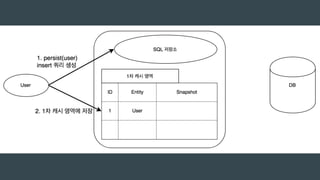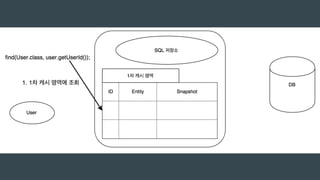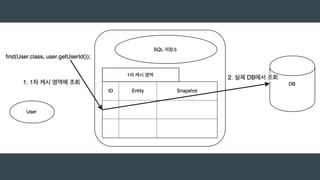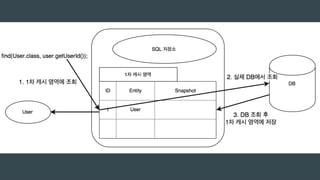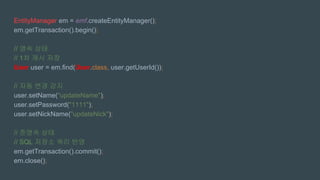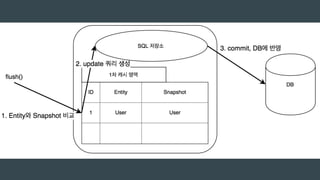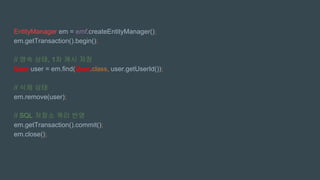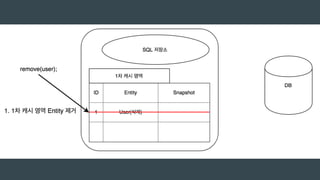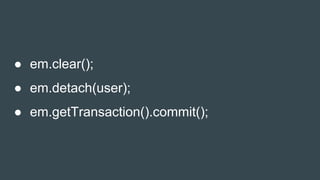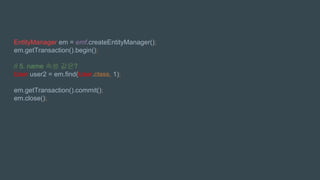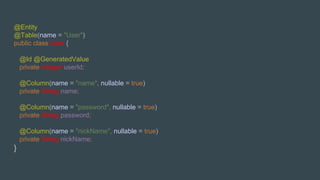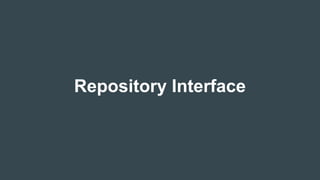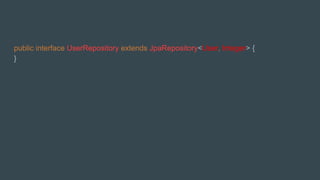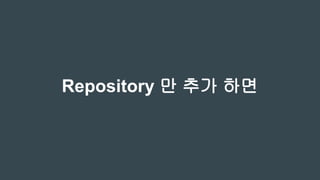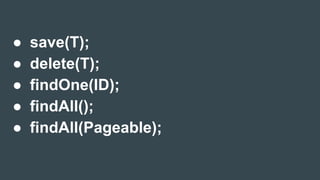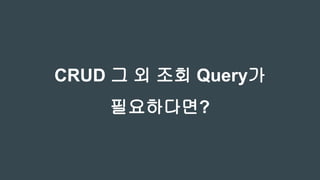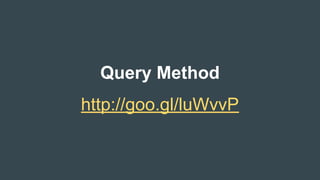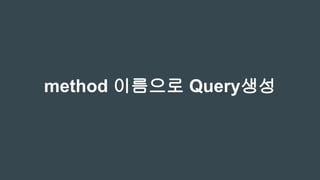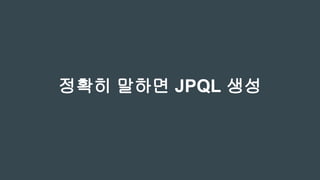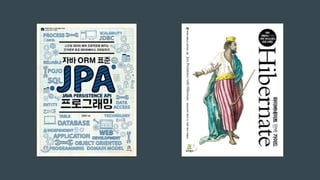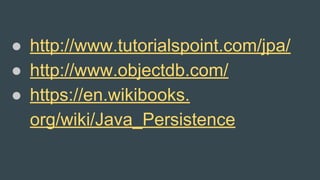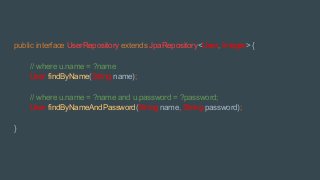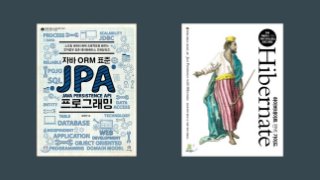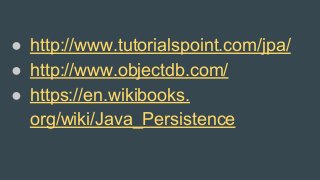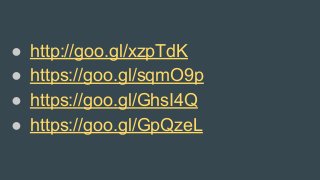Jpa б„Ңб…ЎбҶҜ (б„’б…Ўб„Ӯб…ібҶ« б„Һб…ҘбҶЁ) б„’б…Ўб„Җб…ө
- 1. JPA мһҳ (н•ҳлҠ” мІҷ) н•ҳкё° SLiPP-JPA мқҙкІҪмӣҗ
- 2. лӘ©м°Ё в—Ҹ JPA мҶҢк°ң в—Ҹ JDBCл¶Җн„° JPAк№Ңм§Җ в—Ҹ к°қмІҙмҷҖ н…Ңмқҙлё” в—Ҹ м—”нӢ°нӢ° мғқлӘ…мЈјкё° в—Ҹ мҳҒмҶҚм„ұ м»Ён…ҚмҠӨнҠё в—Ҹ Spring Data JPA в—Ҹ м°ёкі мһҗлЈҢ в—Ҹ QnA
- 3. JPA(Java Persistence API) мҶҢк°ң
- 4. в—Ҹ Java ORM(Object-Relational Mapping) н‘ңмӨҖ F/W в—Ҹ RDBлҘј к°қмІҙлЎң н‘ңнҳ„(л§Өн•‘), мӮ¬мҡ© в—Ҹ Hibernate, Eclipse Link, TopLink Essensials кө¬нҳ„мІҙ
- 7. лӢЁмҲң CRU(мһ…л Ҙ, мЎ°нҡҢ, мҲҳм •) public class User { private int userId; private String name; private String password; }
- 8. JDBC
- 9. // connectionвҖҰ 1. мҝјлҰ¬ мғқм„ұ String insertQuery = "insert into User(userId, name, password) values(?, ?, ?)"; 2. parameter л§Өн•‘ pstmt.setInt(1, user.getUserId()); pstmt.setString(2, user.getName()); pstmt.setString(3, user.getPassword()); 3. мҝјлҰ¬ мӢӨн–ү pstmt.executeUpdate(insertQuery); // close...
- 10. // connectionвҖҰ 1. мҝјлҰ¬ мғқм„ұ String selectQuery = "select userId, name, password from User where userId =" + user.getUserId(); 2. мҝјлҰ¬ мӢӨн–ү ResultSet rs = stmt.executeQuery(selectQuery); 3. лҚ°мқҙн„° л§Өн•‘ user.setUserId(rs.getInt("userId")); user.setName(rs.getString("name")); user.setPassword(rs.getString("password")); // close...
- 11. // connectionвҖҰ 1. мҝјлҰ¬ мғқм„ұ String updateQuery = "update User set name = ?, password = ? where userId = ?"; 2. parameter л§Өн•‘ pstmt.setString(1, user.getName()); pstmt.setString(2, user.getPassword()); pstmt.setInt(3, user.getUserId()); 3. мҝјлҰ¬ мӢӨн–ү pstmt.executeUpdate(updateQuery); // close...
- 12. Query мғқм„ұ, мӢӨн–ү, лҚ°мқҙн„° л§Өн•‘ л°ҳліө
- 13. Connection, close мҪ”л“ң л°ҳліө
- 14. MyBatis
- 15. 1. insert <insert id="inser" parameterType="User"> insert into User(userId, name, password) values (#{userId}, #{name}, #{password}) </insert> 2. select <select id="select" parameterType="java.lang.Integer" resultType="User"> select userId, name, password from User where userId = #{userId} </select> 3. update <update id="update" parameterType="User"> update User set name = #{name}, password = #{password} where userId = #{userId} </update>
- 16. Connection, close мң„мһ„ parameter л§Өн•‘, лҚ°мқҙн„° л§Өн•‘ мң„мһ„
- 17. н•ҳм§Җл§Ң м—¬м „нһҲ Query мһ‘м„ұ л°ҳліө
- 18. JPA
- 19. EntityManager em = entityManagerFactory.createEntityManager(); // Insert em.persist(user); // Select User user = em.find(User.class, user.getUserId()); // Update user.setName("update Name"); user.setPassword("1111"); // Delete em.remove(user);
- 20. Connection, close мң„мһ„ мҝјлҰ¬ мһҗлҸҷ мғқм„ұ, мӢӨн–ү
- 21. User н…Ңмқҙлё”м—җ вҖңnickNameвҖқ 컬лҹјмқҙ 추к°Җ лҗңлӢӨл©ҙ?
- 22. public class User { private int userId; private String name; private String password; // nickName 컬лҹј 추к°Җ private String nickName; }
- 23. JDBC
- 24. 1. insert мҝјлҰ¬ мғқм„ұ String insertQuery = "insert into User(userId, name, password, nickName) values(?, ?, ?, ?)"; 2. parameter л§Өн•‘ pstmt.setInt(1, user.getUserId()); pstmt.setString(2, user.getName()); pstmt.setString(3, user.getPassword()); pstmt.setString(4, user.getNickName()); 3. мҝјлҰ¬ мӢӨн–ү pstmt.executeUpdate(insertQuery);
- 25. 1. select мҝјлҰ¬ мғқм„ұ String selectQuery = "select userId, name, password, nickname from User where userId = " + user.getUserId(); 2. мҝјлҰ¬ мӢӨн–ү ResultSet rs = stmt.executeQuery(selectQuery); 3. лҚ°мқҙн„° л§Өн•‘ user.setUserId(rs.getInt("userId")); user.setName(rs.getString("name")); user.setPassword(rs.getString("password")); user.setNickName(rs.getString("nickName"));
- 26. 1. update мҝјлҰ¬ мғқм„ұ String updateQuery = "update User set name = ?, password = ?, nickName = ? where userId = ?"; 2. parameter л§Өн•‘ pstmt.setString(1, user.getName()); pstmt.setString(2, user.getPassword()); pstmt.setString(3, user.getNickName()); pstmt.setInt(4, user.getUserId()); 3. мҝјлҰ¬ мӢӨн–ү pstmt.executeUpdate(updateQuery);
- 27. Query мҲҳм •, лҚ°мқҙн„° л§Өн•‘ мҪ”л“ң 추к°Җ
- 28. MyBatis
- 29. 1. insert <insert id="inser" parameterType="User"> insert into User(userId, name, password, nickName) values (#{userId}, #{name}, #{password}, #{nickName}) </insert> 2. select <select id="select" parameterType="java.lang.Integer" resultType="User"> select userId, name, password, nickName from User where userId = #{userId} </select> 3. update <update id="update" parameterType="User"> update User set name = #{name}, password = #{password}, nickName = #{nickName} where userId = #{userId} </update>
- 30. Query мҲҳм •
- 32. // insert em.persist(user); // select em.find(User.class, user.getUserId()); // update user.setName("update Name"); user.setPassword("1111"); // delete em.remove(user); // insert em.persist(user); // select em.find(User.class, user.getUserId()); // update user.setName("update Name"); user.setPassword("1111"); user.setNickName("update nickName"); // delete em.remove(user); мҡ”кө¬мӮ¬н•ӯ ліҖкІҪ м „ мҡ”кө¬мӮ¬н•ӯ ліҖкІҪ нӣ„
- 34. в—Ҹ type safe н•ҳм§Җ м•Ҡкі в—Ҹ мӢӨмҲҳн• нҷ•лҘ мқҙ лҶ’кі в—Ҹ мҲҳм •н•ҙм•ј н• мҪ”л“ңк°Җ л§Һм•„м§Җл©° в—Ҹ лӢЁмҲң CRUD мҪ”л“ңлҘј л°ҳліөн•ңлӢӨ.
- 36. н…Ңмқҙлё” м§Җн–Ҙ м—”нӢ°нӢ° public class User { private int userId; private String name; private String password; private String nickName; } public class Board { private int boardId; // foreign key private int userId; private String title; private String content; }
- 37. к°қмІҙ м§Җн–Ҙ м—”нӢ°нӢ° public class User { private int userId; private String name; private String password; private String nickName; } public class Board { private int boardId; // object reference private User user; private String title; private String content; }
- 38. в—Ҹ к°қмІҙ к·ёлһҳн”„ нғҗмғү в—Ҹ н…Ңмқҙлё”кіј к°қмІҙ к°„ м—°кҙҖ кҙҖкі„ л¶Ҳмқјм№ҳ в—Ҹ Query мһ‘м„ұ мҰқк°Җ
- 40. в—Ҹ New(비мҳҒмҶҚ) : DBм—җ л°ҳмҳҒ лҗҳм§Җ м•Ҡкі мҳҒмҶҚм„ұ м»Ён…ҚмҠӨнҠёмҷҖ кҙҖ кі„ м—ҶлҠ” м—”нӢ°нӢ° в—Ҹ Managed(мҳҒмҶҚ) : мҳҒмҶҚм„ұ м»Ён…ҚмҠӨнҠём—җ м ҖмһҘлҗң м—”нӢ°нӢ° в—Ҹ Detached(мӨҖмҳҒмҶҚ) : мҳҒмҶҚм„ұ м»Ён…ҚмҠӨнҠём—җм„ң 분лҰ¬лҗң м—”нӢ°нӢ° в—Ҹ Removed(мӮӯм ң) : мӮӯм ңлҗң м—”нӢ°нӢ°
- 43. // 비 мҳҒмҶҚ User newUser = new User(вҖңnameвҖқ, вҖңpasswordвҖқ, вҖңnickNameвҖқ); // мӨҖ мҳҒмҶҚ User detachUser = new User(1, вҖңnameвҖқ, вҖңpasswordвҖқ, вҖңnickNameвҖқ);
- 44. detachUser.userIdк°Җ DBм—җ мһҲлҠ” кІҪмҡ° вҖөУӨҖмҳҒмҶҚвҖқ
- 46. в—Ҹ м“°кё° м§Җм—° SQL в—Ҹ мһҗлҸҷ ліҖкІҪ к°җм§Җ в—Ҹ 1м°Ё мәҗмӢң в—Ҹ м—”нӢ°нӢ° лҸҷмқјм„ұ в—Ҹ м§Җм—° лЎңл”©
- 47. мҳҒмҶҚм„ұ м»Ён…ҚмҠӨнҠёлҠ” м–ҙл–»кІҢ лҸҷмАҪЗк к№Ң?
- 48. @Entity @Table(name = "User") public class User { @Id @GeneratedValue private Integer userId; @Column(name = "name", nullable = true) private String name; @Column(name = "password", nullable = true) private String password; @Column(name = "nickName", nullable = true) private String nickName; }
- 50. EntityManager em = emf.createEntityManager(); em.getTransaction().begin(); // 비 мҳҒмҶҚ мғҒнғң User user = new User("wons", "12345", "woniper"); // мҳҒмҶҚ мғҒнғң // 1м°Ё мәҗмӢң м ҖмһҘ em.persist(user); // мӨҖмҳҒмҶҚ мғҒнғң // SQL м ҖмһҘмҶҢ мҝјлҰ¬ л°ҳмҳҒ em.getTransaction().commit(); em.close();
- 54. мЎ°нҡҢ(ҙЪҫұІФ»е)
- 55. EntityManager em = emf.createEntityManager(); em.getTransaction().begin(); // мҳҒмҶҚ м—”нӢ°нӢ° // 1м°Ё мәҗмӢң м ҖмһҘ User user = em.find(User.class, user.getUserId()); // мӨҖмҳҒмҶҚ мғҒнғң em.getTransaction().commit(); em.close();
- 60. EntityManager em = emf.createEntityManager(); em.getTransaction().begin(); // мҳҒмҶҚ мғҒнғң // 1м°Ё мәҗмӢң м ҖмһҘ User user = em.find(User.class, user.getUserId()); // мһҗлҸҷ ліҖкІҪ к°җм§Җ user.setName("updateName"); user.setPassword("1111"); user.setNickName("updateNick"); // мӨҖмҳҒмҶҚ мғҒнғң // SQL м ҖмһҘмҶҢ мҝјлҰ¬ л°ҳмҳҒ em.getTransaction().commit(); em.close();
- 65. EntityManager em = emf.createEntityManager(); em.getTransaction().begin(); // мҳҒмҶҚ мғҒнғң, 1м°Ё мәҗмӢң м ҖмһҘ User user = em.find(User.class, user.getUserId()); // мӮӯм ң мғҒнғң em.remove(user); // SQL м ҖмһҘмҶҢ мҝјлҰ¬ л°ҳмҳҒ em.getTransaction().commit(); em.close();
- 69. м§ҖкёҲк№Ңм§Җ лӘЁл“ мқјмқҖ нҠёлһңм қм…ҳ мһ‘м—… лӢЁмң„м—җм„ң лҸҷмһ‘
- 71. flush()лҠ” мҳҒмҶҚм„ұ м»Ён…ҚмҠӨнҠёмҷҖ DBлҘј лҸҷкё°нҷ”
- 72. merge
- 73. мӨҖ мҳҒмҶҚ м—”нӢ°нӢ° -> мҳҒмҶҚ м—”нӢ°нӢ°
- 75. мҳҒмҶҚ м—”нӢ°нӢ° -> мӨҖ мҳҒмҶҚ м—”нӢ°нӢ°
- 76. в—Ҹ em.clear(); в—Ҹ em.detach(user); в—Ҹ em.getTransaction().commit();
- 77. EntityManager em = emf.createEntityManager(); em.getTransaction().begin(); // 1. мҳҒмҶҚ мғҒнғң User user1 = em.find(User.class, 1); // 2. мӨҖмҳҒмҶҚ мғҒнғң em.detach(user1); // 3. name мҶҚм„ұ ліҖкІҪ user1.setName("lee-kyung-won"); // 4. мҳҒмҶҚ мғҒнғң em.merge(user1); em.getTransaction().commit(); em.close();
- 78. EntityManager em = emf.createEntityManager(); em.getTransaction().begin(); // 5. name мҶҚм„ұ к°’мқҖ? User user2 = em.find(User.class, 1); em.getTransaction().commit(); em.close();
- 79. в—Ҹ мҶҚм„ұмқҙ ліҖкІҪлҗң мӨҖмҳҒмҶҚ м—”нӢ°нӢ° merge : update в—Ҹ 비мҳҒмҶҚ м—”нӢ°нӢ° merge : insert
- 80. мҰү mergeлҠ” мҳҒмҶҚ м—”нӢ°нӢ°лЎң л§Ңл“Өкё°лҸ„ н•ҳм§Җ л§Ң update лҳҗлҠ” insert н•ҳкё°лҸ„ н•Ё
- 81. мӨҖ мҳҒмҶҚ мғҒнғңлҠ” мҳҒмҶҚм„ұ м»Ён…ҚмҠӨнҠё нҠ№м§•мқ„ мӮ¬мҡ©н•ҳм§Җ лӘ»н•ҳлҠ” кІғ
- 82. в—Ҹ м“°кё° м§Җм—° SQL в—Ҹ мһҗлҸҷ ліҖкІҪ к°җм§Җ в—Ҹ 1м°Ё мәҗмӢң в—Ҹ м—”нӢ°нӢ° лҸҷмқјм„ұ в—Ҹ м§Җм—° лЎңл”©
- 83. Spring Data JPA
- 85. @Entity @Table(name = "User") public class User { @Id @GeneratedValue private Integer userId; @Column(name = "name", nullable = true) private String name; @Column(name = "password", nullable = true) private String password; @Column(name = "nickName", nullable = true) private String nickName; }
- 87. public interface UserRepository extends JpaRepository<User, Integer> { }
- 88. Repository л§Ң 추к°Җ Зкҳл©ҙ
- 89. в—Ҹ save(T); в—Ҹ delete(T); в—Ҹ findOne(ID); в—Ҹ findAll(); в—Ҹ findAll(Pageable);
- 90. CRUD к·ё мҷё мЎ°нҡҢ Queryк°Җ н•„мҡ”н•ҳлӢӨл©ҙ?
- 93. м •нҷ•нһҲ л§җЗкҳл©ҙ JPQL мғқм„ұ
- 94. л¬јлЎ к·ңм№ҷмқ„ м§Җмјң method мқҙлҰ„ м„Өм •
- 95. public interface UserRepository extends JpaRepository<User, Integer> { // where u.name = ?name User findByName(String name); // where u.name = ?name and u.password = ?password; User findByNameAndPassword(String name, String password); }
- 96. м°ёкі мһҗлЈҢ
- 98. в—Ҹ http://www.tutorialspoint.com/jpa/ в—Ҹ http://www.objectdb.com/ в—Ҹ https://en.wikibooks. org/wiki/Java_Persistence
- 99. в—Ҹ http://goo.gl/xzpTdK в—Ҹ https://goo.gl/sqmO9p в—Ҹ https://goo.gl/GhsI4Q в—Ҹ https://goo.gl/GpQzeL
- 100. QnA
- 101. в—Ҹ blog : http://blog.woniper.net в—Ҹ github : https://github.com/woniper в—Ҹ email : leekw3747@gmail.com



